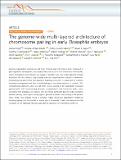The genome-wide multi-layered architecture of chromosome pairing in early Drosophila embryos
Author(s)
Erceg, Jelena; AlHaj Abed, Jumana; Goloborodko, Anton; Lajoie, Bryan R.; Fudenberg, Geoffrey; Abdennur, Nezar Alexander; Imakaev, Maksim Viktorovich; McCole, Ruth B.; Nguyen, Son C.; Saylor, Wren; Joyce, Eric F.; Senaratne, T. Niroshini; Hannan, Mohammed A.; Nir, Guy; Dekker, Job; Mirny, Leonid A; Wu, C.-ting; ... Show more Show less
DownloadPublished version (2.522Mb)
Terms of use
Metadata
Show full item recordAbstract
Genome organization involves cis and trans chromosomal interactions, both implicated in gene regulation, development, and disease. Here, we focus on trans interactions in Drosophila, where homologous chromosomes are paired in somatic cells from embryogenesis through adulthood. We first address long-standing questions regarding the structure of embryonic homolog pairing and, to this end, develop a haplotype-resolved Hi-C approach to minimize homolog misassignment and thus robustly distinguish trans-homolog from cis contacts. This computational approach, which we call Ohm, reveals pairing to be surprisingly structured genome-wide, with trans-homolog domains, compartments, and interaction peaks, many coinciding with analogous cis features. We also find a significant genome-wide correlation between pairing, transcription during zygotic genome activation, and binding of the pioneer factor Zelda. Our findings reveal a complex, highly structured organization underlying homolog pairing, first discovered a century ago in Drosophila. Finally, we demonstrate the versatility of our haplotype-resolved approach by applying it to mammalian embryos.
Date issued
2019-10Department
Massachusetts Institute of Technology. Department of Physics; Massachusetts Institute of Technology. Institute for Medical Engineering & ScienceJournal
Nature Communications
Publisher
Springer Science and Business Media LLC
Citation
Erceg, Jelena et al. "The genome-wide multi-layered architecture of chromosome pairing in early Drosophila embryos." Nature Communications 10, 1 (October 2019): 4486 © 2019 Springer Nature
Version: Final published version
ISSN
2041-1723